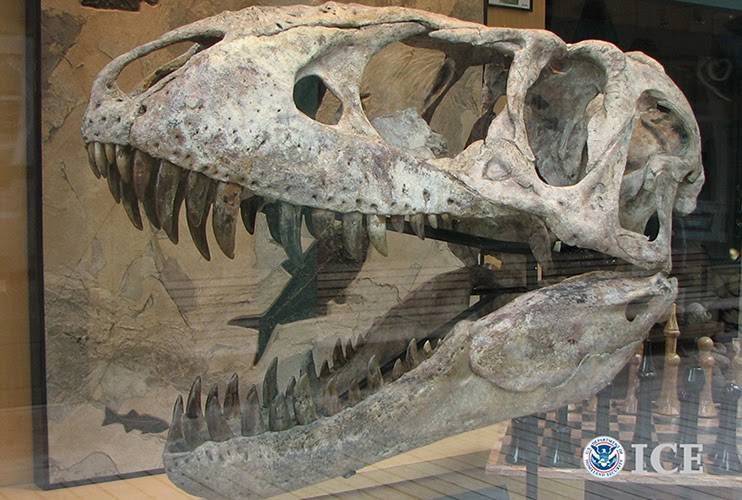“Archeological, historic pieces” from Japan is how the import paperwork described a Tyrannosaurus Bataar skull that illegally entered the United States. But the dinosaur head should have been classified as a paleontological fossil from Mongolia, according to the U.S. Attorney’s Office in Colorado.
 |
| Bataar skull seized by ICE. |
This month John Richard “Rick” Rolater pleaded guilty to conspiring to import dinosaur fossils illegally. As part of a plea agreement with Wyoming federal prosecutors, Rolater agreed not to contest the forfeiture of several paleontological objects in his inventory, including the Bataar skull.
Colorado U.S. Attorney John Walsh says that Rolater “was known as the largest United States seller of high-end Mongolian and Chinese fossils.” In his office’s 11 page forfeiture complaint filed in federal district court last week, prosecutors allege that an informant spotted the Bataar skull for sale in Relator’s store in Jackson, Wyoming boasting a price tag of $320,000. The skull reportedly was “next to a placard stating that the fossil was a Tyrannosaurus Bataar, which existed during the late Cretaceous era, 67 million years ago, and was recovered from the Nemegt Basin in the Gobi Desert, Mongolia, Central Asia.”
When the informant raised questions with the store about the skull’s ownership, a clerk purportedly replied, “Well, I guess that goes to show that if you pay the right people ….,” the prosecutors’ complaint contends.
Prosecutors write in their court pleading that federal officials “seized several computers from the Rolater residence, and located numerous emails that showed Rolater knew it was illegal to import Chinese or Mongolian fossils. Some of the emails further indicated that Rolater conspired with others, and the import Customs forms were knowingly mislabeled, misidentifying the country of origin for the fossils he purchased, and mischaracterizing the contents of the imported items.”
The forfeiture complaint describes an equivocal conversation between one store clerk and an undercover agent with U.S. Immigration and Customs Enforcement Homeland Security Investigations (HSI). The clerk “informed the undercover agent that the fossilized Bataar skull was approximately 60% complete, that the skull was recovered from the Gobi Desert in Mongolia, and that it was recovered from private land in Mongolia in the 1980s, thereby creating the fiction that lawful ownership was conveyed to the possessor of the skull.”
The complaint alleges that “the Bataar skull had been pulled from display [in the store] after the publicized New York seizure of another Bataar, to avoid potential problems.” The store clerk reportedly “told agents that the Bataar fossil subject to seizure was stored in a closet within the [clerk’s] residence, and that Rick Rolater had directed [the clerk] to remove the Bataar” from the store.
The complaint adds that Rolater later told HSI “that his stores had sold five or six Bataar skulls in the past six years, and that he did not currently possess any additional Bataar fossils, other than the one seized in Jackson, Wyoming.” But prosecutors go on to say that Rolater’s lawyer corrected this assertion, explaining that another Bataar skull was inside Rolater’s home in Colorado. HSI seized the skull:
Upon execution of the warrants on August 1, 2012, HSI officers located defendant Bataar Skull, which was found hidden in the crawl space of the residence, and appeared to have been placed there recently. Officers also located defendant Gallimimus Foot in the garage; it had a price tag on it which indicated that it also came from Mongolia. Defendants Bataar Skull and Gallimimus Foot were seized as illegally imported.
The forfeiture complaint concludes that the Bataar skull and the Gallimimus foot were found to have been
excavated in Mongolia in the mid-1990s and smuggled out of the country. The Bataar Skull was shipped to Rolater from Japan in August 2010; the Customs declaration, which Rolater knew was incorrect, listed not only the shipping country as Japan, but also misstated that the country of origin of the fossil was Japan and that the shipped contents consisted of “archeological, historic pieces” (which are man-made), rather than the truthful “paleontological fossils.”
The legal basis upon which the U.S. Attorney’s office relies to forfeit the fossils is 18 U.S.C. § 981(A)(1)(C), which governs civil forfeitures of property derived from the proceeds of a crime. In this case, the crime alleged is smuggling under 18 U.S.C. § 545. Also relied on is 19 U.S.C. § 1595a(c), the customs statute that permits forfeiture of merchandise introduced into the U.S. “contrary to law.” Prosecutors additionally reference Mongolia’s 1924 patrimony law prohibiting personal ownership of cultural property as well as two Mongolian criminal statutes forbidding the transportation and smuggling of cultural objects.
This post is researched, written, and published on the blog Cultural Heritage Lawyer Rick St. Hilaire at culturalheritagelawyer.blogspot.com. Text copyrighted 2010-2014 by Ricardo A. St. Hilaire, Attorney & Counselor at Law, PLLC. Any unauthorized reproduction or retransmission of this post is prohibited. CONTACT INFORMATION: www.culturalheritagelawyer.com
©2010-2022 Cultural Heritage Lawyer Rick St. Hilaire. Content discussing cultural heritage law, art law, looted antiquities, stolen artifacts, and museum risk management that is general information only, not legal advice.


